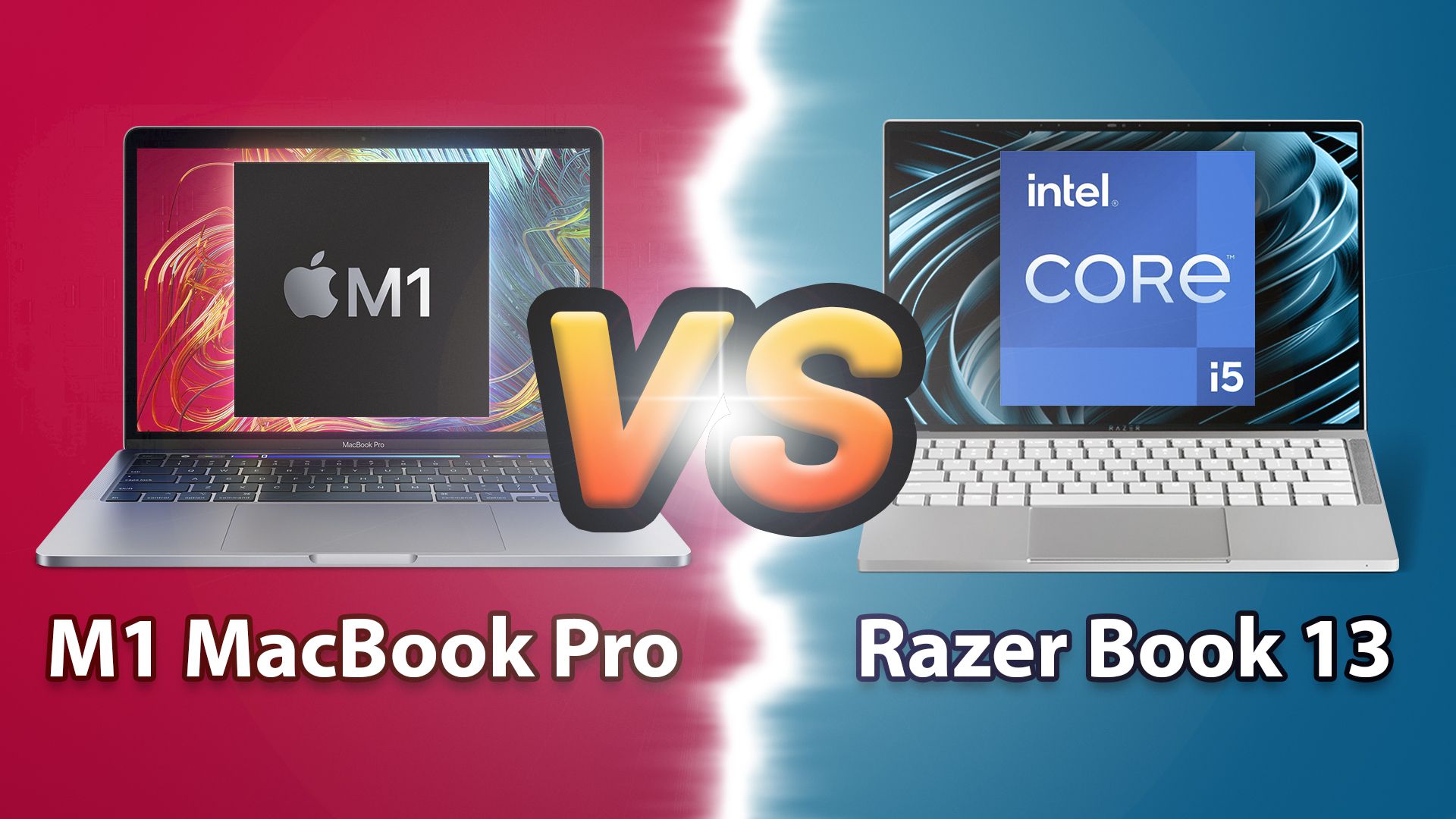
Razer released the Razer Book 13 in November, a new portable laptop focused on productivity rather than gaming. Since it’s similar in many ways to the M1 Macs Apple also launched in November, we thought we’d compare the Razer Book 13 to the M1 MacBook Pro.
As the name suggests, the Razer Book 13 is a 13.4-inch laptop with thin bezels and a matte 60Hz display. It is similar in size to the 13.3-inch M1 MacBook Pro, but is slightly smaller due to the smaller bezel.
/article-new/2021/01/razer-book-macbook-pro-side-by-side.jpg?resize=560%2C315&ssl=1)
Design-wise, the Razer Book 13 has a bit of an edge over the 13-inch MacBook Pro thanks to the Razer’s thin side panels. There is a thicker bezel on the top to house a camera, but the bezel size is still better than the MacBook Pro. Rumors suggest Apple is working on a new 14.1-inch MacBook Pro that might have a slimmer bezel, but for now the Razer wins.
/article-new/2021/01/razer-book-13-web-browser.jpg?resize=560%2C315&ssl=1)
/article-new/2021/01/razer-book-13-web-browser.jpg?resize=560%2C315&ssl=1)
/article-new/2021/01/razer-book-13-web-browser.jpg?resize=560%2C315&ssl=1)
/article-new/2021/01/razer-book-13-web-browser.jpg?resize=560%2C315&ssl=1)
The display differs significantly from the MacBook Pro display in that the Razer Book uses a matte finish, which can be nice in high-glare situations. The glossy display of the MacBook Pro looks great, of course, but can suffer in the bright sun.
/article-new/2021/01/razer-book-macbook-pro-compared.jpg?resize=560%2C315&ssl=1)
/article-new/2021/01/razer-book-macbook-pro-compared.jpg?resize=560%2C315&ssl=1)
/article-new/2021/01/razer-book-macbook-pro-compared.jpg?resize=560%2C315&ssl=1)
/article-new/2021/01/razer-book-macbook-pro-compared.jpg?resize=560%2C315&ssl=1)
Both machines have similar keyboard designs with roughly the same key spacing, but there are some differences here. The MacBook Pro has a Touch Bar, which some people have never gotten used to, while the Razer Book has RBG key lighting that can be a distraction for some.
/article-new/2021/01/razer-book-vs-macbook-pro-trackpad.jpg?resize=560%2C315&ssl=1)
/article-new/2021/01/razer-book-vs-macbook-pro-trackpad.jpg?resize=560%2C315&ssl=1)
/article-new/2021/01/razer-book-vs-macbook-pro-trackpad.jpg?resize=560%2C315&ssl=1)
/article-new/2021/01/razer-book-vs-macbook-pro-trackpad.jpg?resize=560%2C315&ssl=1)
The MacBook Pro has speaker grilles on each side of the keyboard, a haptic glass trackpad that’s more comfortable to use than the physical trackpad on the Razer Book, and better thermal management. The fans of the M1 fans MacBook Pro rarely arrive due to the efficiency of the M1 chip, but the Razer fans turn almost as soon as they do something intense. Even running the Microsoft Edge browser on battery powered the Razer Book fans.
/article-new/2021/01/razer-macbook-pro-keyboard-comparison.jpg?resize=560%2C315&ssl=1)
/article-new/2021/01/razer-macbook-pro-keyboard-comparison.jpg?resize=560%2C315&ssl=1)
/article-new/2021/01/razer-macbook-pro-keyboard-comparison.jpg?resize=560%2C315&ssl=1)
/article-new/2021/01/razer-macbook-pro-keyboard-comparison.jpg?resize=560%2C315&ssl=1)
The fans of the Razer Book are located on the bottom of the machine, so if you use this in a round there is a chance that the airflow will be blocked. The MacBook Pro doesn’t have fans on the bottom, so it’s better for lap use, with warm air escaping from the hinge area.
Ports are an area where the Razer Book 13 can be an advantage for some users. It features two Thunderbolt 4 / USB-C ports, a 3.5mm audio jack, a USB-A port, an HDMI 2.0 port and a microSD slot. The MacBook Pro, meanwhile, has two Thunderbolt 4 / USB-C ports and a 3.5mm audio jack.
/article-new/2021/01/razer-ports-macbook-ports.jpg?resize=560%2C315&ssl=1)
/article-new/2021/01/razer-ports-macbook-ports.jpg?resize=560%2C315&ssl=1)
/article-new/2021/01/razer-ports-macbook-ports.jpg?resize=560%2C315&ssl=1)
/article-new/2021/01/razer-ports-macbook-ports.jpg?resize=560%2C315&ssl=1)
When it comes to performance, the M1 chip beats the 11th generation Intel chips that Razer uses. In a Geekbench test, the M1 MacBook Pro scored 1734 in single-core performance and 7531 in multi-core performance. The Razer Book achieved a single-core score of 1355 and a multi-core score of 5290. As for OpenCL, the M1 MacBook Pro scored 19412 and the Razer 14761.
/article-new/2021/01/razer-book-13-chroma-keys.jpg?resize=560%2C315&ssl=1)
/article-new/2021/01/razer-book-13-chroma-keys.jpg?resize=560%2C315&ssl=1)
/article-new/2021/01/razer-book-13-chroma-keys.jpg?resize=560%2C315&ssl=1)
/article-new/2021/01/razer-book-13-chroma-keys.jpg?resize=560%2C315&ssl=1)
The Razer Book’s performance isn’t bad in any way here and these are both very capable machines that will excel in everyday tasks, but the M1 MacBook Pro is better at more intensive tasks like video or photo editing.
/article-new/2021/01/macbook-pro-closed.jpg?resize=560%2C315&ssl=1)
/article-new/2021/01/macbook-pro-closed.jpg?resize=560%2C315&ssl=1)
/article-new/2021/01/macbook-pro-closed.jpg?resize=560%2C315&ssl=1)
/article-new/2021/01/macbook-pro-closed.jpg?resize=560%2C315&ssl=1)
Apple’s MacBook Pro also has better battery life. Apple says it will take up to 20 hours, and while we haven’t quite seen it hit that maximum (that’s for watching videos), it survived the Razer Book. The Razer Book lasts up to nine hours.
The base model Razer Book with 256 GB of storage, 8 GB of RAM and the aforementioned 11th Gen Core i5 Intel chip and Intel Iris Xe graphics costs $ 1200, so it’s $ 100 cheaper than the 13-inch M1 MacBook Pro that also gets comes with 256 GB storage and 8 GB RAM.
/article-new/2021/01/razer-book-13-closed.jpg?resize=560%2C315&ssl=1)
/article-new/2021/01/razer-book-13-closed.jpg?resize=560%2C315&ssl=1)
/article-new/2021/01/razer-book-13-closed.jpg?resize=560%2C315&ssl=1)
/article-new/2021/01/razer-book-13-closed.jpg?resize=560%2C315&ssl=1)
Most notably, the M1 MacBook Pro runs macOS Big Sur and the Razer Book 13 runs Windows, and the ecosystem is probably the biggest consideration when choosing between these machines. Those deep into Apple’s ecosystem will make more use of the M1 MacBook Pro, while those who rely on Windows software will prefer the Razer Book 13.
Overall, though, these are comparable machines and while the M1 MacBook Pro wins in performance and efficiency, the Razer Book 13 is a capable laptop for those who need or prefer the Windows operating system.